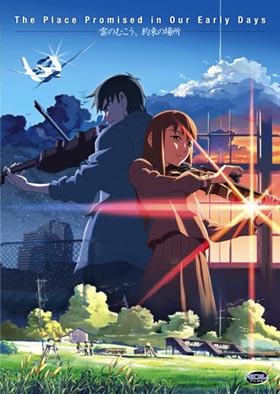| |
|
review | notes | awards | availability | |

Availability:
DVD (USA)
Region 1 NTSC
A.D. Vision
16x9 Anamorphic Widescreen
Japanese and English Language Tracks
Dolby Digital 5.1
Removable English Subtitles
Video Interviews with the Japanese Cast, Video Interview
with Makoto Shinkai, Original Japanese Trailer Collection,
and Previews
Awards:
59th
Annual Mainichi Film Concours
• Winner - Noburoh Ohfuji Award for Technical
Excellence
2003 Tokyo
International Anime Fair
• Winner - Award for Expression Technique
Notes:
• The film's theater run in Tokyo was extended,
twice. It was originally only going to run from Nov.
20th to Dec. 24th, but was extended to Jan. 14th because
of overwhelming fan response. They later held over
the film again until the end of January. On the night
of its premiere, the film broke Japan's Cinemarise
Theatres' audience attendance records.
|
|
|
Review by
Calvin
McMillin: |
Makoto Shinkai, touted
by some as the next Hayao Miyazaki, follows up his
acclaimed short film Voices of a Distant Star
with the 2004 animated movie The Place Promised
in Our Early Days. Part love story, part sci-fi
opus, the picture details the relationship between
three teenagers, and how the pact they made in the
past comes to have consequences for all their futures,
and perhaps even Japan's.
The story takes place
in an alternate timeline in which Japan was split
in two after the Second World War. While the Southern
Alliance works hand-in-hand with the United States,
the Northern Union is far more enigmatic. The Union
constructs a gigantic tower that stretches so far
into the heavens that it can be seen for miles. Its
purpose, however, remains a mystery. Amidst this tense
border conflict, two young boys, Hiroki Fujisawa and
Takuya Shirakawa decide to build a plane so they breeze
past the tower. While at school, the two make friends
with Sayuri Sawatari, a cute girl whose youthful exuberance
only serves to inspire the boys even more to complete
their project. As the three youngsters bond, the boys
promise to bring Sayuri along with them whenever the
plane is ready for takeoff.
But things take a sharp
turn when Sayuri suddenly disappears. Disheartened
by her abrupt absence, the boys eventually lose interest
and abandon their bold idea altogether. Even worse,
the two boys begin to drift apart. Takuya becomes
a scientist investigating the truth behind the Union
Tower: apparently, it's actually a kind of gateway
to parallel dimensions. As the fog of war between
the north and south looms heavily over the proceedings,
Takuya joins up with a terrorist faction looking to
take down the Tower, which they view as the WMD to
end all WMDs.
Meanwhile, Hiroki finds himself
haunted by nightmares that show Sayuri trapped in
a dream world, frightened and alone. Believing he
is the only one who can help her, Hiroki returns to
the workshop he and Takuya shared as teenagers. Hiroki
believes Sayuri's fate is somehow tied to the mysterious
tower and succeeds in making contact with her in the
dream world. When Sayuri's true whereabouts are made
clear, Hiroki does everything in his power to honor
the promise he made to her years ago. However, there's
one person standing in Hiroki's way: his former best
friend, Takuya. Will the promise be fulfilled or has
the friendship wholly disintegrated?
From start to finish,
The Place Promised in Our Early Days is not
your typical science fiction film. Quiet and introspective,
the movie plays out like a coming-of-age romance,
one that contrasts the sunny idealism of youth against
the cold hard facts of adulthood. And with its emphasis
on flashback and voiceover, the movie often feels
like a dreamy, yet somehow realistic novel. Parallel
universes, civil war, and technological marvels just
happen to populate the world of The Place Promised
in Our Early Days, but they aren't the focus.
Certainly, the sci-fi element figures strongly into
the film, but it is weaved into the narrative in such
a believable, often unobtrusive manner that one can
see how this sort of story could succeed even without
the sci-fi trappings.
If there are any complaints
that could be laid against the film, it would have
to be in reference to its ending, which feels less
triumphant than it does perfunctory and woefully abrupt.
One could argue that the characters have reached the
end of their arcs, and thus, there's nothing more
to tell, but in this case, the opaqueness of the finale
makes it seem like the filmmakers figured they'd go
for open-endedness rather than actually craft a truly
satisfying resolution. The ending serves its purpose
and doesn't detract from the entirety of the film,
but it would have been nice to have a conclusion that
matched up with all that preceded it.
Visually, of course,
the film is a sight to behold. With its rich color
palette and beautifully rendered scenes, The Place
Promised in Our Early Days is nothing short of
breathtaking. But it's not all about pretty pictures.
With its beautiful score, well-drawn characters, and
intriguing premise, The Place Promised in Our Early
Days offers up a thoroughly engaging cinematic
experience. Makoto Shinkai is definitely one filmmaker
worth keeping an eye on. (Calvin McMillin, 2005)
|
|